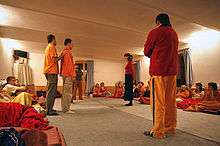Family Constellations

Family Constellations, also known as Systemic Constellations and Systemic Family Constellations, is an alternative therapeutic method which draws on elements of family systems therapy, existential phenomenology and Zulu attitudes to family.[1] In a single session, a Family Constellation supposedly attempts to reveal a previously unrecognized systemic dynamic that spans multiple generations in a given family and to resolve the deleterious effects of that dynamic by encouraging the subject to encounter representatives of the past and accept the factual reality of the past.
Family Constellations diverges significantly from conventional forms of cognitive, behaviour and psychodynamic psychotherapy. The method has been described by physicists as quantum quackery, and its founder Bert Hellinger incorporates the pseudoscientific idea of morphic resonance into his explanation of it. Positive outcomes from the therapy have been attributed to conventional explanations such as suggestion and empathy.[2]
Practitioners claim that present-day problems and difficulties may be influenced by traumas suffered in previous generations of the family, even if those affected now are unaware of the original event in the past. Hellinger referred to the relation between present and past problems that are not caused by direct personal experience as Systemic entanglements, said to occur when unresolved trauma has afflicted a family through an event such as murder, suicide, death of a mother in childbirth, early death of a parent or sibling, war, natural disaster, emigration, or abuse.[3] The psychiatrist Iván Böszörményi-Nagy referred to this phenomenon as Invisible Loyalties.[4]
Conceptual basis
The philosophical orientation of Family Constellations were derived through an integration of existential phenomenology family systems therapy and elements of indigenous spiritual mysticism.
The phenomenological lineage can be traced through philosophers Franz Brentano, Edmund Husserl and Martin Heidegger. This perspective stands in contrast to the positivist reductionist orientation of the scientific psychology. Rather than understanding mind, emotion and consciousness in terms of its constituent parts, existential phenomenology opens perception to the full panorama of human experience and seeks to grasp a sense of meaning.[5]
Family Constellations take their form from family systems psychology. Leading figures in this movement whose influence can be recognized include Jacob Moreno, the founder of psychodrama; Iván Böszörményi-Nagy, the pioneer of transgenerational systemic thinking; Milton Erickson, a pioneer of brief therapy and hypnotherapy; Eric Berne who conceived the concept of life scripts; and Virginia Satir, who developed family sculpture, the precursor of Systemic Constellations.[5] In the past decade, further advancements in the use of the process have been innovated by practitioners throughout the world.
The process draws from indigenous spiritual mysticism to contribute towards releasing tensions, lightening emotional burdens, and resolving real-world problems. Hellinger lived as a Roman Catholic priest in South Africa for 16 years in the 1950s and 1960s. During these years, he became fluent in the Zulu language, participated in their rituals, and gained an appreciation for their distinct worldview.[5]
Of particular importance is the difference between traditional Zulu attitudes toward parents and ancestors and those typically held by Europeans. Heidegger postulated that to be human is to find oneself thrown into a world with no clear logical, ontological, or moral structure.[6] In Zulu culture, Hellinger found a certitude and equanimity that were the hallmarks of Heidegger's elusive authentic Self. The traditional Zulu people lived and acted in a religious world in which the ancestors were the central focal point. The ancestors were regarded as positive, constructive, and creative presences.[7] The connection with ancestors is a central feature of the Constellation process.
The term "Family Constellations" was first used by Alfred Adler in a somewhat different context to refer to the phenomenon that each individual belongs to and is bonded in relationship to other members of his or her family system.
The method

This description is the prototype group Family Constellation as developed by Bert Hellinger in the 1990s.[5] Many practitioners have blended Constellation work with psychological aspects of healing. Others have kept the classic form as taught by Bert Hellinger, such as the Constellation Approach.[8] The Constellation Approach merges concepts of Family Constellations, energy medicine, and consciousness studies to complement the understanding of classic Constellation methodology.
- A group (workshop) is led by a facilitator. In turn, members of the group can explore an urgent personal issue. Generally, several members will be given an opportunity to set up a Constellation in each session.
- After a brief interview, the facilitator suggests who will be represented in the Constellation. These are usually a representative for the seeker, one or more family members, and sometimes abstract concepts such as "depression" or a country.
- The person presenting the issue (seeker or client) asks people from the group to stand in the Constellation as representatives. He or she arranges the representatives according to what feels right in the moment. The seeker then sits down and observes.
- Several minutes elapse with the representatives standing still and silent in their places. Initially, unlike psychodrama, the representatives do not act, pose, dialogue or role play.
- Emphasis is placed on perceptive intuition in placing the representatives and in subsequent steps of the procedure. The aim is supposedly to tune into what the psychiatrist Albrecht Mahr describes as the Knowing Field[9] and former biologist Rupert Sheldrake has suggested is morphic resonance.[10] The Knowing Field is claimed to guide participants to perceive and articulate feelings and sensation that mirror those of the real family members they represent; however, representative perception (morphic resonance) is not a concept with any scientific basis. The representatives have little or no factual knowledge about those they represent. Nevertheless, the representatives usually experience feelings or physical sensations that are thought to inform the process.
- The facilitator may ask each representative to briefly report how they feel being placed in relation to the others. The facilitator, seeker, and group members may believe they perceive an underlying dynamic in the spatial arrangement and feelings held by the representatives that influence the presenting personal issue. Often, configuring multiple generations in a family is thought to reveal that severe traumas continue to unconsciously affect the living long after the original victims or perpetrators have died.
- A healing resolution for the issue generally is supposedly achieved after re-positioning the representatives and adding key members of the system who have been forgotten or written out of the family history. When every representative feels right in his or her place and the other representatives agree, the facilitator may suggest one or two sentences to be spoken aloud. If the representatives do not feel at peace with their new position or sentences, they can move again or try a different sentence. This is claimed, in an abstract way, to represent a possible resolution of the issues faced by the seeker. Sometimes the process concludes without a full resolution being achieved.
- When the facilitator feels that the healing resolution has taken hold among the representatives, the seeker is invited to "replace his/her representative in the Constellation". This supposedly allows the seeker to perceive how it feels to be part of a reconfigured system. When everyone feels comfortable in their place, the Constellation concludes.
References
- ↑ Cohen, D. B. (2006). ""Family Constellations": An Innovative Systemic Phenomenological Group Process from Germany". The Family Journal. 14 (3): 226. doi:10.1177/1066480706287279.
- ↑ Carroll, Robert T. "Bert Hellinger and family constellations". skepdic.com.
- ↑ Hellinger, B., Weber, G., & Beaumont, H. (1998). Love's hidden symmetry: What makes love work in relationships. Phoenix, AZ: Zeig, Tucker and Theisen.
- ↑ Boszormenyi-Nagy, I., & Spark, G. M. (1973). Invisible loyalties: Reciprocity in intergenerational family therapy. Hagerstown, MD: Harper & Row.
- 1 2 3 4 Cohen, D. B. (2006). "Family Constellations": An innovative systemic phenomenological group process from Germany. The Family Journal: Counseling and Therapy for Couples and Families, 14, 226-233.
- ↑ Heidegger, M. (1962). Being and time (J. Macquarrie & E. Robinson, translators). New York: Harper & Row (original work published 1927).
- ↑ Lawson, E. T. (1985). Religions of Africa. New York: Harper and Row.
- ↑ "The Constellation Approach"
- ↑ Mahr, A. (1999). "Das wissende feld: Familienaufstellung als geistig energetisches heilen" ["The knowing field: Family constellations as mental and energetic healing"]. In Geistiges heilen für eine neue zeit [Intellectual cures for a new time]. Heidelberg, Germany: Kösel Verlag.
- ↑ Sheldrake, R. (1988). The presence of the past: Morphic resonance and the habits of nature. Rochester, VT: Park Street.
Further reading
- Boszormenyi-Nagy, Ivan; Spark, G. M. (1973). Invisible loyalties: Reciprocity in intergenerational family therapy. Harper & Row.
- Cohen, Dan Booth (2009). I Carry Your Heart in My Heart: Family Constellations in Prison. Carl Auer-Systeme Verlag International.
- Cohen, Dan Booth (2005). "Begin with the work: Constellations in large group systems". In E. J. Lynch & S. Tucker. Messengers of healing: The family constellations of Bert Hellinger through the eyes of a new generation of practitioners. Zeig, Tucker & Theisen.
- Franke, Ursula (2003). The river never looks back: Historical and practical foundations of Bert Hellinger's family constellations. Carl-Auer-Systeme Verlag.
- Lynch, Ed; Tucker, Suzi (2005). Messengers of healing: The family constellations of Bert Hellinger through the eyes of a new generation of practitioners. Zeig, Tucker & Theisen.
- Mahr, Albrecht (1999). "Das wissende Feld: Familienaufstellung als geistig energetisches Heilen (The knowing field: Family constellations as mental and energetic healing)". Geistiges heilen für eine neue Zeit. Kösel Verlag.
- Mahr, Albrecht (2004). "Family Constellations – Failure, Evil, and Guilt as Sources for Loving Dedication and Compassionate Strength". Family Constellations Albrecht Mahr.
- Payne, John L. (2005). The Healing of Individuals, Families and Nations: Trans-generational healing & family constellations. Findhorn Press.
- Payne, John L. (2006). The Language of the Soul: Trans-Generational Healing & Family Constellations. Findhorn Press.
- Singer; Lalich, Janja (1996). Crazy Therapies. Jossey-Bass.